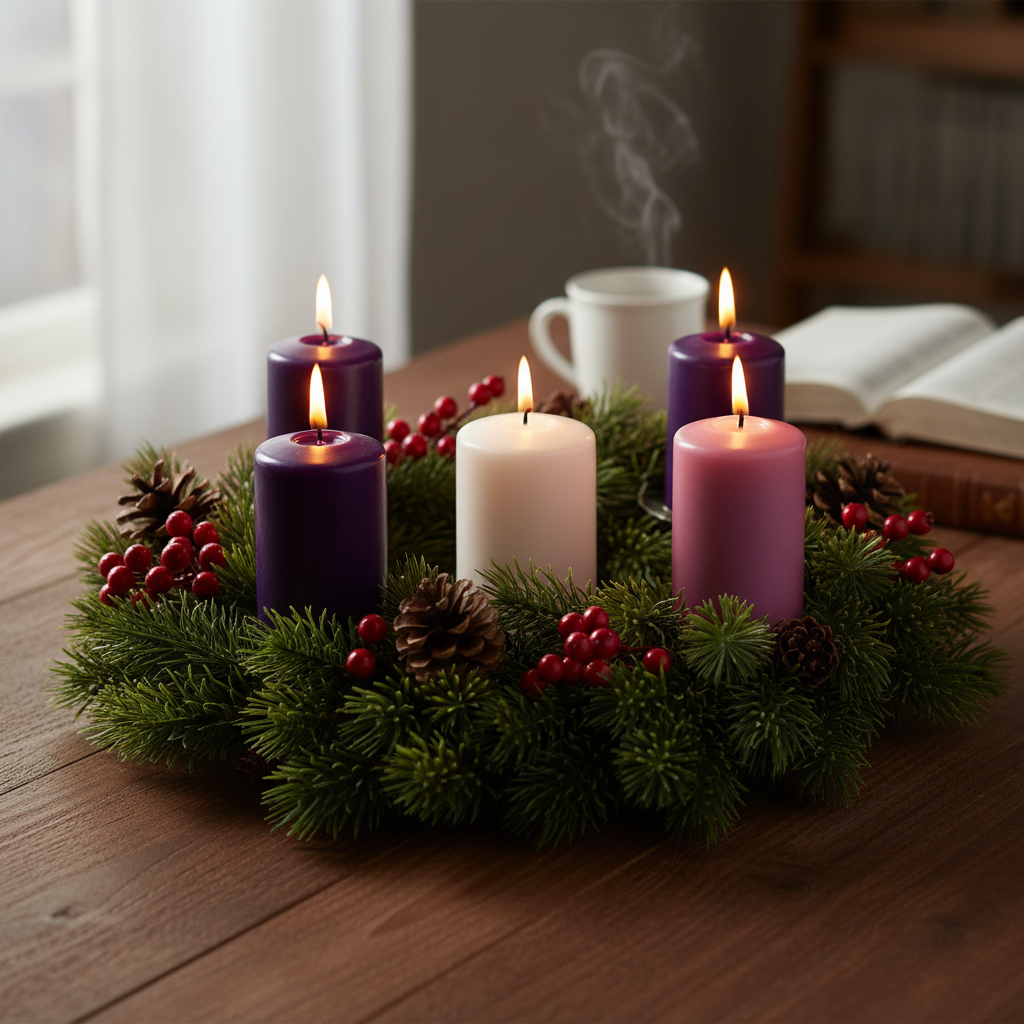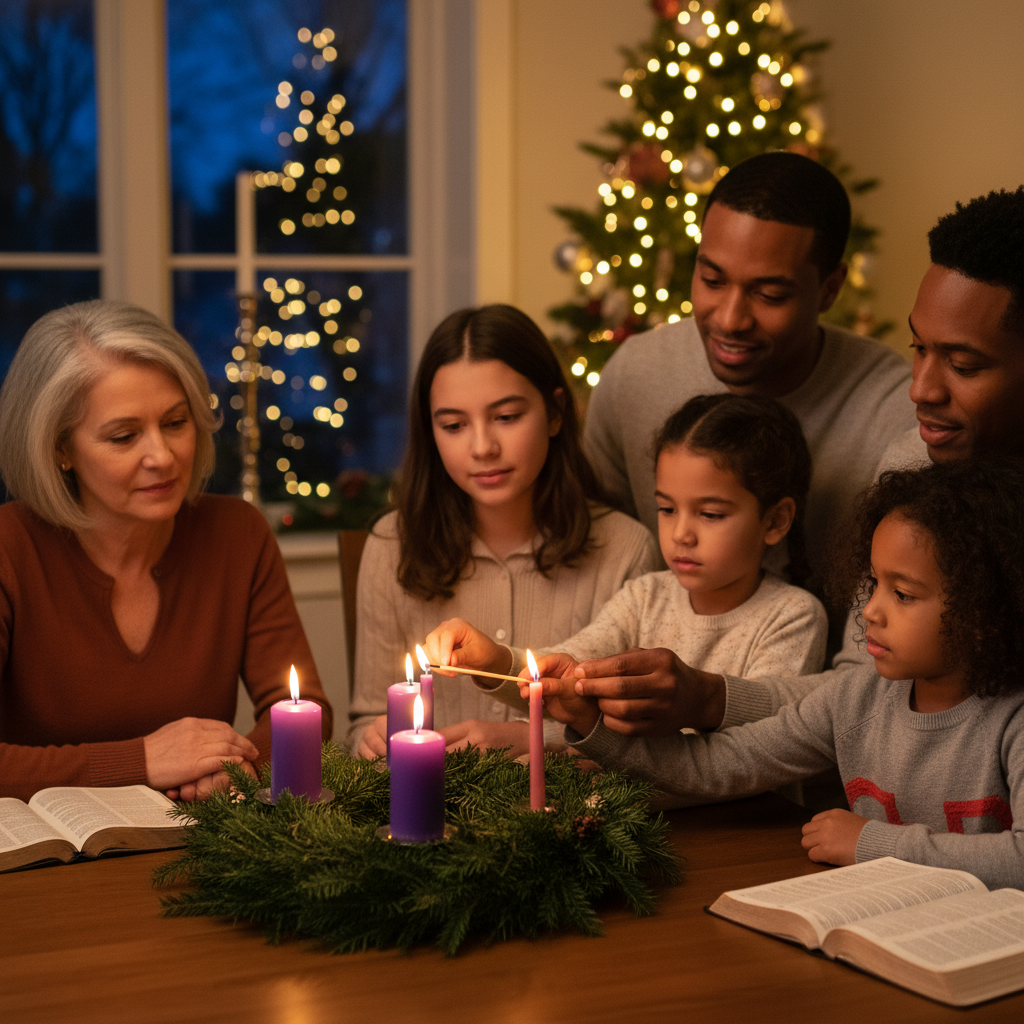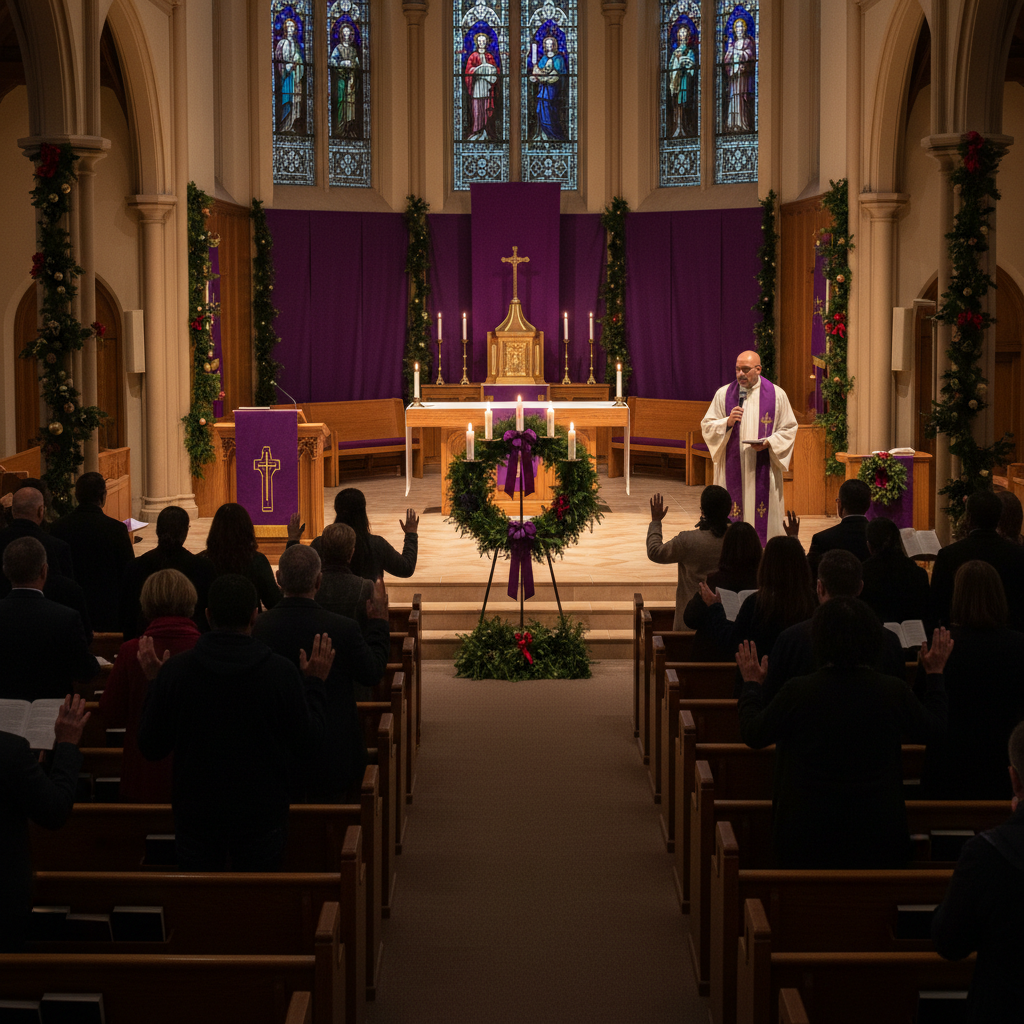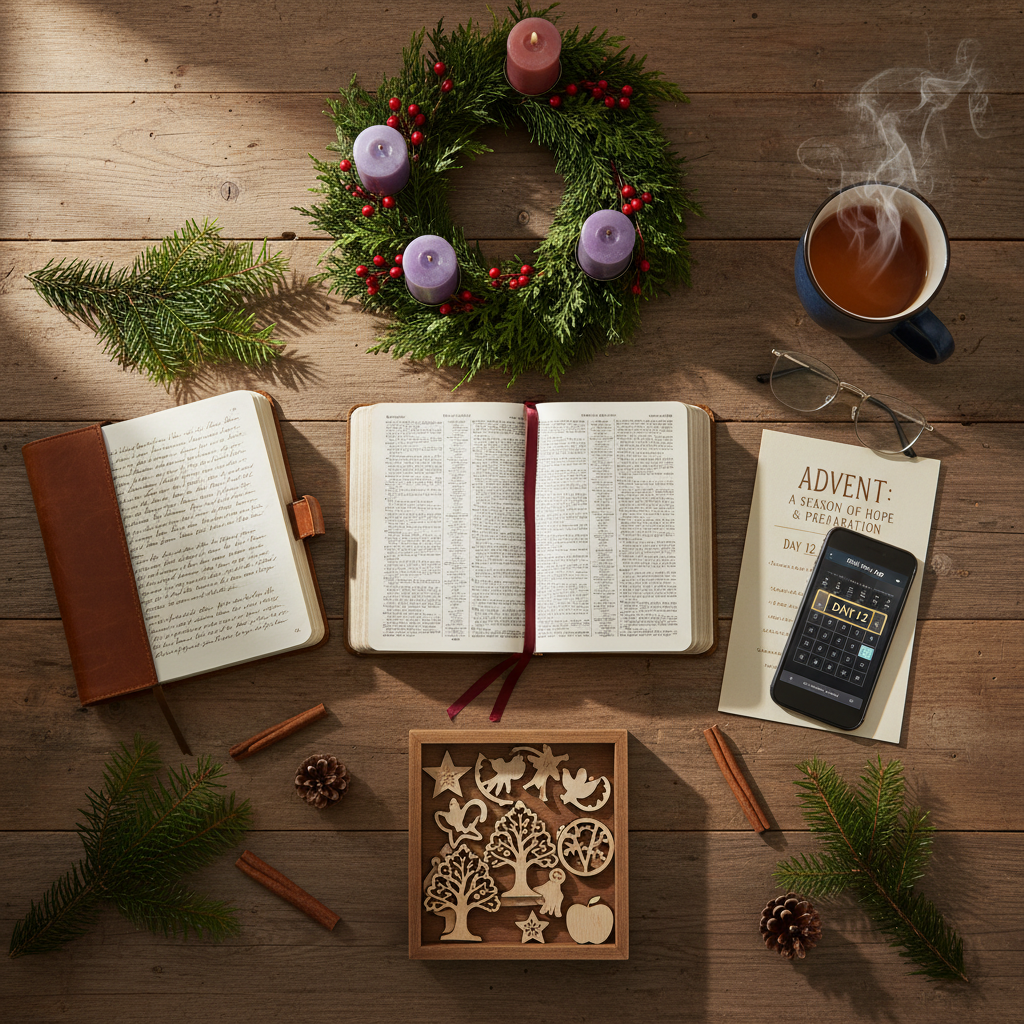Picture this: It's 11:47 PM on November 30th in Munich, and a young mother named Gerhard's wife (we don't know her first name, which tells you something about 19th-century Germany) is frantically cutting colored paper to create a makeshift calendar for her impatient son. Little Gerhard Lang keeps asking every single day, "Is it Christmas yet?" Finally, his mother creates 24 tiny doors on a piece of cardboard, each hiding a small treat or Bible verse. The year is 1851. She has just invented what will become the modern Advent calendar, though she doesn't know it yet.
That story is probably apocryphal (most good origin stories are), but it captures something essential about Advent: the ache of waiting, the need for rituals to mark time, and the desire to make anticipation meaningful rather than agonizing. What Gerhard's mother understood intuitively is what Christians have practiced for over a millennium. Waiting matters. How you wait matters. And the season before Christmas is not merely endured but celebrated as a spiritual journey in its own right.
Advent (from the Latin "adventus," meaning "coming" or "arrival") is the four-week season before Christmas, beginning on the fourth Sunday before December 25th. It's a season practiced across nearly every branch of Christianity, from ancient Orthodox cathedrals in Constantinople to contemporary evangelical mega-churches in Dallas. But here's what's fascinating: Advent isn't really about Christmas at all. At least, not just about Christmas.
The Double Lens of Advent: First Coming, Second Coming
Traditional Advent holds two realities in tension. Yes, Christians prepare to celebrate Christ's first coming (His birth in Bethlehem roughly 2,000 years ago), but they simultaneously anticipate His second coming (His promised return to consummate history). This dual focus gives Advent its peculiar spiritual weight. You're not just remembering a past event. You're positioning yourself in the long arc of redemption history, between two advents.
Early Christians didn't celebrate Advent the way we do. For the first three centuries, the church focused primarily on Easter, the resurrection of Christ. Christmas as a distinct celebration didn't emerge until the 4th century, and Advent as a preparatory season developed gradually over the next several hundred years. By the 6th century, various forms of Advent observance existed across Europe, though they looked quite different from region to region.
In Gaul (modern-day France), Advent began on November 11th (St. Martin's Day) and included 40 days of fasting, mirroring Lent before Easter. In Rome, Advent was shorter, beginning four Sundays before Christmas with a more contemplative rather than penitential character. Pope Gregory I standardized the Roman approach in the 6th century, establishing the four-week structure that most Western churches follow today. Eastern Orthodox traditions developed their own Nativity Fast, which begins November 15th and lasts 40 days.

How Advent Became a Cultural Phenomenon (and Then Almost Disappeared)
For much of Christian history, Advent remained a church observance practiced primarily in liturgical worship. Families might attend special Advent services, but home practices were limited. Then came the 19th century and the Victorian romanticization of Christmas. Suddenly, Christmas became a domestic holiday centered on families, children, and home celebrations. This created both opportunity and crisis for Advent.
The opportunity: Christian families began creating home rituals that brought Advent into daily life. Advent wreaths, popularized by German Lutherans in the 1830s, moved from church altars to dining room tables. Advent calendars (remember young Gerhard Lang?) emerged in the late 1800s and became commercial products by the early 1900s. These tangible, family-friendly practices made Advent accessible to children and created memorable traditions that reinforced faith formation.
The crisis: As Christmas became increasingly commercialized throughout the 20th century, Advent nearly disappeared under the weight of consumer culture. By the 1950s and 60s, Christmas decorations appeared in stores immediately after Halloween. The idea of "waiting" for Christmas felt quaint and irrelevant in a culture of instant gratification. Why wait when you can have the Christmas experience (or at least the merchandise) starting in October?
But here's what happened: Starting in the 1980s and accelerating dramatically in the 2000s, Christians across denominations began reclaiming Advent as a counter-cultural practice. In an age of consumer frenzy, endless advertising, and holiday stress, Advent offered something radical, a spiritually grounded way to resist the chaos and actually prepare your heart for Christmas. Evangelical churches that had never practiced liturgical seasons began creating Advent sermon series. Catholic parishes saw renewed participation in traditional Advent devotions. Orthodox communities found Western Christians suddenly interested in the Nativity Fast.
The Advent Wreath: Every Element Tells a Story
Few Christian symbols pack more theological meaning into a simple physical object than the Advent wreath. Let's unpack each layer because this matters for understanding why Advent works as a spiritual practice.
The Circle: No beginning, no end. God's eternal nature. The cycle of seasons. In pre-Christian Germanic cultures, circles held protective power. Early Christians baptized this symbol (as they did with many cultural elements) to represent divine eternity and the unbroken promises of God.
The Evergreen: In the depths of winter, when everything appears dead, evergreens remain alive and green. For ancient people living through harsh winters, this was profound. Evergreens symbolized hope that life would return, that darkness wouldn't last forever. Christians saw in evergreens a perfect symbol for eternal life through Christ, who brings spring to dead souls even in winter's darkness.
The Four Candles: Traditionally three purple (or blue) and one pink, representing the four weeks of Advent. The colors carry meaning. Purple (or blue in some traditions) represents royalty, penitence, and preparation. The single pink candle, lit on the third Sunday, is called the Gaudete candle (Latin for "Rejoice"). It marks the midpoint of Advent when anticipation shifts from patient waiting to joyful expectation.
The Christ Candle: The central white candle, lit on Christmas Eve or Christmas Day, represents Christ Himself, the Light of the World. Everything in the Advent wreath points toward this moment when light fully arrives. The progressive lighting of candles, one each Sunday, creates a visual metaphor for increasing light as Christ's coming draws near.
Here's what makes the Advent wreath powerful as a spiritual practice: It's multi-sensory (sight, smell of evergreen, warmth of candles), involves the whole family, marks time in a visible way, and creates a focal point for daily or weekly devotions. When your five-year-old asks why we're lighting another candle, you have a teaching moment. When your teenager helps arrange the evergreen branches, they're engaging with symbol and tradition. When your family gathers around the lit wreath before dinner, you're creating sacred space in ordinary time.

The Four Themes: Hope, Peace, Joy, Love
The four Sundays of Advent are traditionally associated with four themes that create a narrative arc through the season. Different traditions assign these themes to different weeks, but the most common pattern is Hope, Peace, Joy, and Love. These aren't arbitrary concepts. They trace a theological progression that mirrors both the Old Testament preparation for Christ and the Christian experience of salvation.
Week 1: Hope - The Prophets' Promise
The first week focuses on prophetic hope, the centuries-long expectation that God would send a Messiah to redeem His people. Scripture readings typically come from Isaiah, Jeremiah, and other prophets who foretold Christ's coming. "The people walking in darkness have seen a great light" (Isaiah 9:2). "A shoot will come up from the stump of Jesse" (Isaiah 11:1). This week situates Christmas in the long story of redemption, reminding us that Christ's birth was not a random event but the fulfillment of specific promises made over centuries.
Hope, in Christian theology, is not wishful thinking. It's confident expectation based on God's character and promises. The first week of Advent trains us to see our own lives within this pattern of promise and fulfillment. We live between Christ's first and second coming, waiting with the same hope that sustained Abraham, Moses, and Isaiah. When we light the first purple candle, we're joining a chorus of voices stretching back millennia, voices that hoped against hope that God would keep His word.
Week 2: Peace - The Angels' Announcement
The second week shifts to peace, centered on the angelic announcement to the shepherds: "Glory to God in the highest heaven, and on earth peace to those on whom his favor rests" (Luke 2:14). This is the peace of reconciliation, the end of hostility between God and humanity. Christ is the Prince of Peace (Isaiah 9:6), and His birth inaugurates a new era where peace with God becomes possible through His eventual sacrificial death.
But Advent invites us to sit with the irony: Christ comes to bring peace, yet He arrives into a world of violence. Herod will soon slaughter infants. Mary and Joseph will become refugees fleeing to Egypt. The peace Christ offers is not the absence of conflict but the presence of God even in chaos. It's the peace that "surpasses understanding" (Philippians 4:7), available even when circumstances remain difficult. This week challenges our consumer Christmas fantasy of perfect peaceful gatherings and reminds us that true peace is found in God's presence, not perfect circumstances.
Week 3: Joy - The Shepherds' Response
The third week celebrates joy, and here's where the Advent progression becomes clear. Hope leads to peace, which produces joy. This is Gaudete Sunday, named after the Latin word for "Rejoice." The pink candle breaks the purple progression, visually signaling a shift. We're past the halfway point. Christmas is coming soon. The mood shifts from penitential preparation to anticipatory celebration.
The joy of Advent is not manufactured happiness. It's the deep gladness that comes from knowing God keeps His promises. Mary's Magnificat (Luke 1:46-55) is the soundtrack for this week: "My soul glorifies the Lord and my spirit rejoices in God my Savior." This is the joy of the oppressed being lifted up, the hungry being filled, the proud being scattered. It's revolutionary joy that upends worldly power structures. When we light the pink candle, we're declaring that God's upside-down kingdom is breaking in, and that reality produces joy no circumstance can extinguish.
Week 4: Love - God's Incarnation
The fourth week focuses on love, the climax of Advent's themes. "For God so loved the world that he gave his one and only Son" (John 3:16). This week we're at Christmas's doorstep. The narrative of Jesus' birth dominates readings: Mary and Joseph's journey to Bethlehem, the census, the search for lodging, the birth itself. Everything culminates in this stunning reality: God loves humanity so much that He becomes human.
The Incarnation (God taking on flesh) is Christianity's most scandalous claim and Advent's ultimate focus. The infinite becomes finite. The eternal enters time. The Creator becomes creature. Divine love doesn't remain abstract or distant but gets His hands dirty, experiences hunger, feels cold, knows human limitations. When we light the fourth purple candle, we're acknowledging that love is not primarily a feeling but an act of profound solidarity. God joins us in our humanity to redeem it from within.

Consumer Christmas vs. Sacred Waiting: The Cultural Collision
Here's the tension every modern Christian faces: You want to observe Advent, to enter into sacred waiting, to prepare spiritually for Christmas. But you're drowning in consumer Christmas starting November 1st. The mall plays "Jingle Bells" on repeat. Your inbox overflows with Black Friday deals. School concerts, office parties, and neighborhood gatherings pack your calendar. Social media displays everyone's perfect decorations and photogenic family moments. The culture around you treats December as one long Christmas celebration, not a season of preparation for Christmas.
This collision isn't new, but it has intensified. In the 1950s, Christmas advertising began creeping earlier, but stores still generally waited until after Thanksgiving. By the 1980s, Christmas merchandise appeared in October. Now Christmas content on social media starts in September, and retailers begin holiday sales before Halloween. The cultural momentum toward instant Christmas gratification makes Advent's patient waiting feel not just counter-cultural but nearly impossible.
Yet this is precisely why Advent matters more now than ever. In an age of instant gratification, subscription services that deliver anything within 24 hours, and social media's constant dopamine hits, the spiritual discipline of waiting is revolutionary. Advent says: Slow down. Not everything should be immediate. Anticipation has value. Preparation matters. The journey toward Christmas is part of the celebration, not an obstacle to overcome.
Practically, this doesn't mean refusing all Christmas activities until December 25th. You'll attend the office party. Your kids will participate in school concerts. You'll navigate family expectations around decorating and gift-giving. But Advent creates space within the chaos for something deeper. Maybe you wait until the second week of Advent to put up your tree (while still attending your neighborhood's early December party). Maybe you combine Christmas shopping with daily Advent devotions (the activities aren't mutually exclusive). Maybe you explain to your children why your family has an Advent wreath while their friends don't, turning it into a teaching moment about different ways to celebrate.
The goal isn't liturgical perfection or cultural isolation. It's creating enough space for spiritual preparation that Christmas morning feels like arriving at a destination you've been journeying toward, not just another day in a month-long celebration that's already exhausted you.
Personal Transformation: When Advent Changes You
Let me tell you about Jennifer, a marketing executive in Chicago. For fifteen years, December meant professional chaos (year-end campaigns, client dinners, holiday parties) combined with family obligations (decorating, shopping, cards, hosting). She loved Christmas but arrived at Christmas Day utterly depleted. One year, her pastor introduced Advent wreaths to their non-denominational church. Jennifer was skeptical. More religious obligations? No thanks.
But something her pastor said stuck with her: "What if Advent isn't about adding more but about adding meaning to what you're already doing?" So Jennifer tried it. She bought a simple wreath and lit the candles at dinner (when she actually ate dinner at home, which wasn't always). She used a short Advent devotional, just five minutes a day. She didn't transform her entire December or opt out of work commitments or family traditions. She just added this small thread of spiritual focus.
What changed wasn't her circumstances. Her December stayed chaotic. What changed was her internal landscape. Those five minutes of Advent reading and candle lighting created a daily touchstone, a moment of re-centering. When client stress peaked, she remembered the Hope theme from week one and found herself praying, "God, You keep Your promises." When family tensions erupted over holiday plans, she recalled the Peace theme and chose different responses. By Christmas, Jennifer wasn't less tired physically, but she was less depleted spiritually. She'd stayed connected to the meaning underneath the chaos.
Or consider the Rodriguez family in San Antonio, parents of three kids under ten. Christmas had become a stress-fest of managing expectations, navigating commercialism, and keeping up with what other families posted on Instagram. They decided to try a full Advent observance: daily devotions, Advent calendar with Scripture rather than candy, Jesse Tree ornaments tracing Christ's lineage. Their kids initially resisted ("Why can't we have chocolate like our friends?"). But by the second week, something shifted.
Their seven-year-old started asking to light the Advent candles. Their five-year-old memorized the four themes and corrected adults: "No, Grandma, this is Peace week, not Joy week. Joy comes next!" On Christmas morning, when they lit the white Christ candle together, their oldest said, "We've been waiting for this all month." The parents realized: their kids now understood Christmas as the culmination of something, not just the arrival of presents. That understanding has more lasting value than any toy under the tree. The Advent journey gave their children a framework for understanding Christmas within the larger story of God's faithfulness, and that framework would shape how they approach faith for years to come.
The Jesse Tree: Tracing Salvation History Day by Day
Among Advent practices, the Jesse Tree stands out for its pedagogical power, especially with children. Named after Isaiah 11:1 ("A shoot will come up from the stump of Jesse; from his roots a Branch will bear fruit"), the Jesse Tree traces Jesus' family tree and the broader salvation story from Creation through Christ's birth.
Here's how it works: You have a tree (real branch, artificial tree, or even a poster on the wall) and a set of ornaments representing key Old Testament figures and events. Each day from December 1-25, your family reads a Scripture passage and hangs the corresponding ornament. Day 1 might be Creation (apple ornament for the Garden of Eden). Day 2 is Noah (ark ornament). Day 3 is Abraham (stars ornament for God's promise of descendants). You progress through Isaac, Jacob, Joseph, Moses, Ruth, David, Solomon, the prophets, and finally arrive at the New Testament nativity story.
What makes the Jesse Tree brilliant is that it situates Jesus' birth within the entire biblical narrative. Children learn that Christmas isn't a standalone story but the climax of God's long faithfulness. They see how God worked through flawed people (Abraham lied, Jacob deceived, David committed adultery and murder) to accomplish His redemptive purposes. They understand that Jesus comes from a real family tree with real history, connecting the Old and New Testaments in tangible ways.
For parents, the Jesse Tree provides a structure for teaching Scripture naturally. You're not lecturing about theology; you're telling stories your kids want to hear. "Tonight we learn about Moses and the burning bush!" The daily ornament becomes a conversation starter. The growing tree visualizes the progression of God's plan. By Christmas, the tree is full, representing the fullness of time when God sent His Son. It's biblical education through narrative and symbol, which is how humans have always learned best.

Different Traditions, Same Longing: How Christians Worldwide Celebrate Advent
Walk into a Catholic church in Rome during Advent, and you'll find purple vestments, specific Mass readings following the liturgical calendar, and priests chanting the O Antiphons (ancient Latin prayers) during the final week. Cross town to an Orthodox church, and you'll encounter the Nativity Fast, 40 days of reduced food intake and intensified prayer starting November 15th. Visit a Lutheran church in Minnesota, and you'll experience rich Advent hymns, wreath lighting ceremonies, and perhaps a "Hanging of the Greens" service where the congregation decorates the sanctuary together while singing. Drop in on a Southern Baptist church in Georgia, and you might find a contemporary Advent sermon series with family devotional resources, adapting traditional practices to non-liturgical worship styles.
These differences matter less than their commonality. Across Catholic, Orthodox, Anglican, Lutheran, Methodist, Presbyterian, and increasingly evangelical traditions, Christians worldwide are rediscovering Advent as a necessary pause before Christmas. The specifics vary, wreaths versus fasting, liturgy versus contemporary teaching, Latin chants versus modern worship songs, but the core impulse is identical: to slow down, focus on Christ, and prepare spiritually rather than merely materially for Christmas.
In Latin America, Catholic communities practice Las Posadas during the nine days before Christmas, reenacting Mary and Joseph's search for lodging. Families process neighborhood to neighborhood, singing and asking for shelter, being turned away until finally welcomed in. This dramatic retelling makes Advent tangible, especially for children who experience rejection and hospitality firsthand.
In Germany, Christmas markets (Weihnachtsmärkte) open during Advent, but they maintain the distinction between Advent and Christmas. Markets sell Advent calendars, wreath supplies, and decorations, but the focus remains preparatory. The Christmas celebration doesn't fully begin until December 24th. This cultural reinforcement of Advent makes the spiritual practice easier when society supports the rhythm.
In Ethiopia, Orthodox Christians observe Genna (Christmas) on January 7th following the Julian calendar, preceded by a 43-day fast called Tsome Nebiyat. Believers abstain from meat and dairy, attend lengthy church services, and engage in charitable acts. The fast intensifies focus on spiritual preparation, making Genna's arrival profoundly celebratory.
What's remarkable about Advent's diversity is that it demonstrates Christianity's ability to adapt universal truths to cultural contexts. The core reality (Christ came, Christ will come again, prepare your heart) remains constant. The practices that embody that reality flex to fit different cultures, languages, and worship styles. This flexibility is not weakness but strength. It means Advent can work in a liturgical cathedral or a house church, in Manila or Minneapolis, for a solitary contemplative or a chaotic family of seven.
Practical Advent: Creating Your Family or Personal Practice
Theory is easy. Implementation is where Advent lives or dies. You're convinced Advent matters, but how do you actually do it? Here's the honest truth: Start smaller than you think you should. The biggest mistake people make with Advent is attempting too much and burning out by December 10th.
If you're starting Advent practice for the first time: Get an Advent devotional book or use a digital resource. Commit to five minutes daily. That's it. Don't add wreath making, Jesse Tree construction, and volunteer commitments in year one. Build the habit of daily spiritual focus first. You can expand in future years.
If you have young children (ages 3-10): Visual, tactile elements are essential. Advent calendar with daily Scripture passages works better than chocolate (controversial, but true for sustained engagement). Let kids light the Advent wreath candles (supervised, obviously). Use a Jesse Tree with ornaments they can touch and move. Keep devotions short (10 minutes maximum) but consistent. Daily is better than perfect.
If you have teenagers: Involve them in creating the practice rather than imposing it. Ask, "What would make Advent meaningful for you?" Maybe they lead evening candle lighting. Maybe they choose the devotional readings. Maybe they create an Advent playlist. Ownership increases engagement. Also, acknowledge that their schedule is crazy too. Find one family Advent moment per week rather than forcing daily participation when they have finals and basketball tournaments.
If you're single or married without kids: Advent can be beautifully contemplative. Consider joining a church Advent study group for community. Use a more substantial devotional that allows deeper reflection. Attend special Advent services (lessons and carols, Taizé prayer, candlelight services). Create personal Advent rituals, morning coffee with Scripture reading, evening candle lighting with journaling, weekly Advent concert attendance.
If your church doesn't practice Advent: You can still observe it personally or as a family. Many excellent resources exist for independent Advent observation. Consider starting an Advent study group at your church, introducing the practice gently without demanding everyone participate. Remember that Advent is a tool for spiritual formation, not a litmus test for authentic Christianity. If your church meaningfully prepares hearts for Christmas through other means, that's fine. Advent is a means, not the end.
The Advent Paradox: Waiting for What Already Came
Here's the theological depth that makes Advent more than nostalgic tradition: You're waiting for an event that already happened 2,000 years ago while simultaneously awaiting an event that hasn't happened yet. This dual temporal orientation is unique to Advent. You're neither purely historical (just remembering the past) nor purely eschatological (just anticipating the future). You're both, simultaneously.
This "already but not yet" tension defines Christian existence. Christ has already come (the Kingdom broke into history at Bethlehem). Christ has not yet come in fullness (the Kingdom awaits consummation at His return). We live in the in-between, and Advent trains us to inhabit that space faithfully. We're not merely awaiting something to happen; we're living in light of what has happened and what will happen.
This is why Advent readings include both Old Testament prophecies of Christ's first coming and New Testament texts about His second coming. On a single Sunday, you might read Isaiah's promise of a virgin bearing a son (backward looking) and Jesus' teaching about being ready for His return like servants awaiting their master (forward looking). You hold both realities together, and in doing so, you learn to live faithfully in the present.
The practical impact of this dual orientation is profound. You don't despair when circumstances are hard because you know God has already demonstrated faithfulness in Christ's first coming. You don't become complacent about injustice or suffering because you know Christ's return will set all things right. You live with grateful memory and hopeful expectation, and that combination produces patient, faithful action in the present.
Why Bible Way's Advent Study Works
Digital tools can either help or hinder Advent practice. Done poorly, they add notification noise and screen time to an already overwhelming season. Done well, they provide structure, community, and accessibility that deepens Advent observance. Bible Way's Advent study belongs in the second category, and here's why it works.
First, it meets you where you are. You don't need a physical wreath, Jesse Tree ornaments, or any special supplies. Everything works digitally, perfect for apartments without mantle space or families who travel frequently. The app unlocks new content daily, creating anticipation and rhythm without requiring you to remember which reading comes next. Notifications gently remind without badgering, respecting that your December is busy.
Second, it scales to your life stage. Parents of young children find age-appropriate activities and discussion questions. Teenagers can access deeper theological content and participate in youth-specific Advent challenges. Adults studying alone appreciate scholarly notes and historical context. You're not forced into a one-size-fits-all approach that works for no one in particular.
Third, it builds community. Virtual Advent groups connect you with others on the same journey. You can join family groups (coordinating across distances when relatives live in different states), church groups (even if your local church doesn't formally observe Advent), or affinity groups (young adults, seniors, Spanish speakers, etc.). The isolation many feel during hectic December dissolves when you know thousands of others are lighting candles, reading Scripture, and preparing hearts alongside you.
Fourth, it honors tradition while embracing technology. You get the historic themes (Hope, Peace, Joy, Love), Scripture-based readings, and liturgical structure that have formed Christians for centuries. But you access these through a medium that fits modern life. This isn't tradition versus innovation. It's tradition delivered through innovation, maintaining what matters while adapting the method.

What Happens After Advent: Making Christmas More Meaningful
Here's the test of whether Advent worked: Christmas morning arrives, and instead of feeling vaguely disappointed that the buildup is over, you feel ready. You've prepared. The gifts matter less because something deeper has been happening. When you light the white Christ candle in the center of your Advent wreath on Christmas Eve or Christmas morning, it represents culmination, not just another December day.
Families who observe Advent consistently report that Christmas becomes more meaningful, not less. The children understand what they're celebrating beyond presents and Santa. Adults feel spiritually nourished rather than depleted. Church attendance on Christmas doesn't feel obligatory but like arriving at a destination you've been journeying toward. The Scripture readings during Christmas services connect to weeks of prior study, creating continuity and depth.
Moreover, Advent practice often continues its impact throughout the year. Families who establish daily devotional rhythms during Advent find it easier to maintain those rhythms afterward. The habit of gathering around Scripture, lighting candles, and praying together doesn't have to end December 25th. Many families transition directly into Epiphany observance (the twelve days after Christmas focusing on the Magi's visit and Christ's manifestation to the Gentiles), extending the liturgical season and maintaining spiritual momentum.
The most profound impact, though, is how Advent reshapes your understanding of waiting itself. We live in a culture that treats waiting as purely negative, something to minimize or eliminate. Fast shipping, instant streaming, immediate communication. Advent teaches that waiting can be generative, that anticipation has value, that the journey matters as much as the destination. This counter-cultural lesson applies far beyond Christmas. When you learn to wait hopefully during Advent, you develop capacity to wait faithfully in other areas: career transitions, health challenges, relationship difficulties, unanswered prayers. Advent becomes training in the spiritual discipline of patience, grounded in confidence that God keeps His promises even when fulfillment is delayed.
Starting This Year: Your First Advent Journey
If you've never observed Advent before, this year is the year to start. Not next year when life is calmer (it won't be). Not when your kids are older or your schedule is clearer. This year. Now. Even if you're reading this December 10th and you've "missed" the beginning, start where you are. Advent grace means it's never too late to begin preparing your heart for Christ.
You don't need perfect conditions or complete understanding. You need willingness to try something counter-cultural: slowing down during the busiest month, focusing spiritually when cultural momentum pulls toward material concerns, waiting when instant gratification is available. Download Bible Way's Advent study. Light a candle tonight. Read tomorrow's Scripture passage. That's it. That's how you begin.
Give yourself permission to do Advent imperfectly. You'll miss days. Your kids will complain. You'll be distracted during readings. That's fine. The goal isn't flawless execution but faithful presence. God meets you in the attempt, not in the perfection. What matters is creating space, however small and imperfect, for Christ in the chaos of December.
Twenty-five days from now, when Christmas morning arrives and you light that white Christ candle, you'll understand something you don't yet: Advent wasn't just preparation for Christmas. It was preparation for living faithfully in the long Advent of history, the time between Christ's first and second coming when we wait with hope, peace, joy, and love for the consummation of all things. Advent is practice for Christian existence itself. And you're about to begin.
